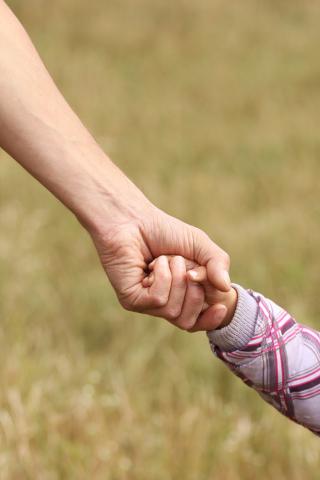
Image via Shutterstock.com
A Federal Program that Can Provide Support During the Critical Early Years
My youngest child just turned 12, but I can still remember how hard it was when my children were babies: the lack of sleep, the colicky evenings, the diaper blow-outs, the meals eaten with one hand, the worry when they ran a fever.
But I never had to worry about whether we’d have a place to sleep at night, or enough to eat, and I never tried to wash and reuse a disposable diaper because I couldn’t afford to buy more. For too many parents of infants, that’s not the case. In 2014, nearly one-quarter of all babies under the age of 1 were in poor families, as were more than one-third of Black and Hispanic babies.
Raising a baby in poverty is scary and stressful for parents, and has lasting consequences for children’s well-being as they grow up. A large and growing body of research has shown that experiences during the infant and toddler years shape the architecture of the brain as well as the biological responses to stress, and lay the foundation for future growth, learning and health. Poverty in early childhood is a grave threat to children’s long-term health, well-being, and educational success, with persistent and deep poverty causing the most damage.
Poor working parents of infants are caught in a terrible bind. While a national law, the Family Medical Leave Act (FMLA), provides up to 12 weeks leave and ensures covered workers get their jobs back, that leave is unpaid. And many low wage workers are ineligible even for the unpaid leave because of rules that keep the program off limits to employees in small firms (under 50) and those who have too little tenure in their jobs. Nearly 45 percent of all workers are ineligible because of these rules, with young workers and less educated workers most likely to be ineligible.
Because we have no federal paid family and medical leave law most workers have to cobble together vacation days and sick days offered by their employers. However, low-wage workers often have jobs that also fail to provide such paid time off. Further, when they do return to work, they are likely to experience unpredictable and unstable schedules, which are both stressful and make it hard to access stable and high-quality child care.
What if we created a program to serve these poor families, to meet their immediate needs and protect them from destitution, to give new parents some relief from stress so that they have a bit more time and attention to give their children, and to help pay for quality child care when they return to work?
In theory, we already have such a program, Temporary Assistance for Needy Families, or TANF, a federal initiative that’s operated by states and whose first goal is “to provide assistance to needy families so that children may be cared for in their own homes or in the homes of relatives.” However, in practice, TANF programs often fall short of this goal and represent a missed opportunity to ensure that poor children have a healthy start in life. Barriers to access, underfunded services, and work requirements that do not take the needs of infants into account hold parents back and make it harder for them to lift themselves and their babies out of poverty.
In a recent CLASP report, TANF and the First Year of Life: Making a Difference at a Pivotal Moment, Stephanie Schmit, and I describe the ways in which TANF falls short of its potential, suggest an innovative framework for thinking about TANF in the context of the first year of life, present a vision for what a reformed TANF might look like, and lay out concrete steps that states can begin taking right now to move their programs in this direction. TANF offers an important, large-scale, high-impact opportunity to achieve two-generational goals for poor families with infants because it already reaches about a quarter million of the poorest families with babies or pregnant women (about half of deeply poor families with infants).
Here’s just one example of how a family can fall through the holes in the safety net. Denise,* a 27-year-old mother living in Ohio, has newborn twins. She had to stop working over the summer because of problems with the pregnancy. Before that, she had done janitorial work through a temporary agency. Her pediatrician told her that she shouldn’t put the twins, who both have some health issues, in child care at least until they have received their first round of vaccinations at two months. But she can’t receive TANF cash assistance because she previously received benefits for her older children several years ago, and reached Ohio’s 36-month time limit on TANF benefits. She asked, but was told that she did not qualify for a hardship exemption to the time limit. When asked what not being able to get cash assistance means to her family, she said “it’s the difference between paying rent and being able to buy my kids’ clothes. It means I can’t provide the things that my kids need. You want the best for your kids and it’s a terrible feeling not be able to provide for them.”
In our report, we lay out a framework for how states can make changes within TANF to offer more support—through cash assistance, child care, home visiting, and connections to health care, and nutrition programs -- to families with babies during this critical time. Having a baby is both joyful and stressful for all parents. Unfortunately, poor parents often have far more than their share of stress— and poorly designed programs can add to that stress, rather than providing needing support. The negative consequences for their children – and our nation -- can be profound and long lasting. By revisiting their TANF programs, states can better support poor families and make real improvements in the lives of babies and toddlers living in poverty, so that they have a better chance of succeeding at school and beyond.
*Name changed to protect her privacy. Denise is a client of the Cincinnati Child Health-Law Partnership (Child HeLP) and gave permission to share her story.



The views and opinions expressed in this post are those of the author(s) and do not necessarily reflect those of MomsRising.org.
MomsRising.org strongly encourages our readers to post comments in response to blog posts. We value diversity of opinions and perspectives. Our goals for this space are to be educational, thought-provoking, and respectful. So we actively moderate comments and we reserve the right to edit or remove comments that undermine these goals. Thanks!